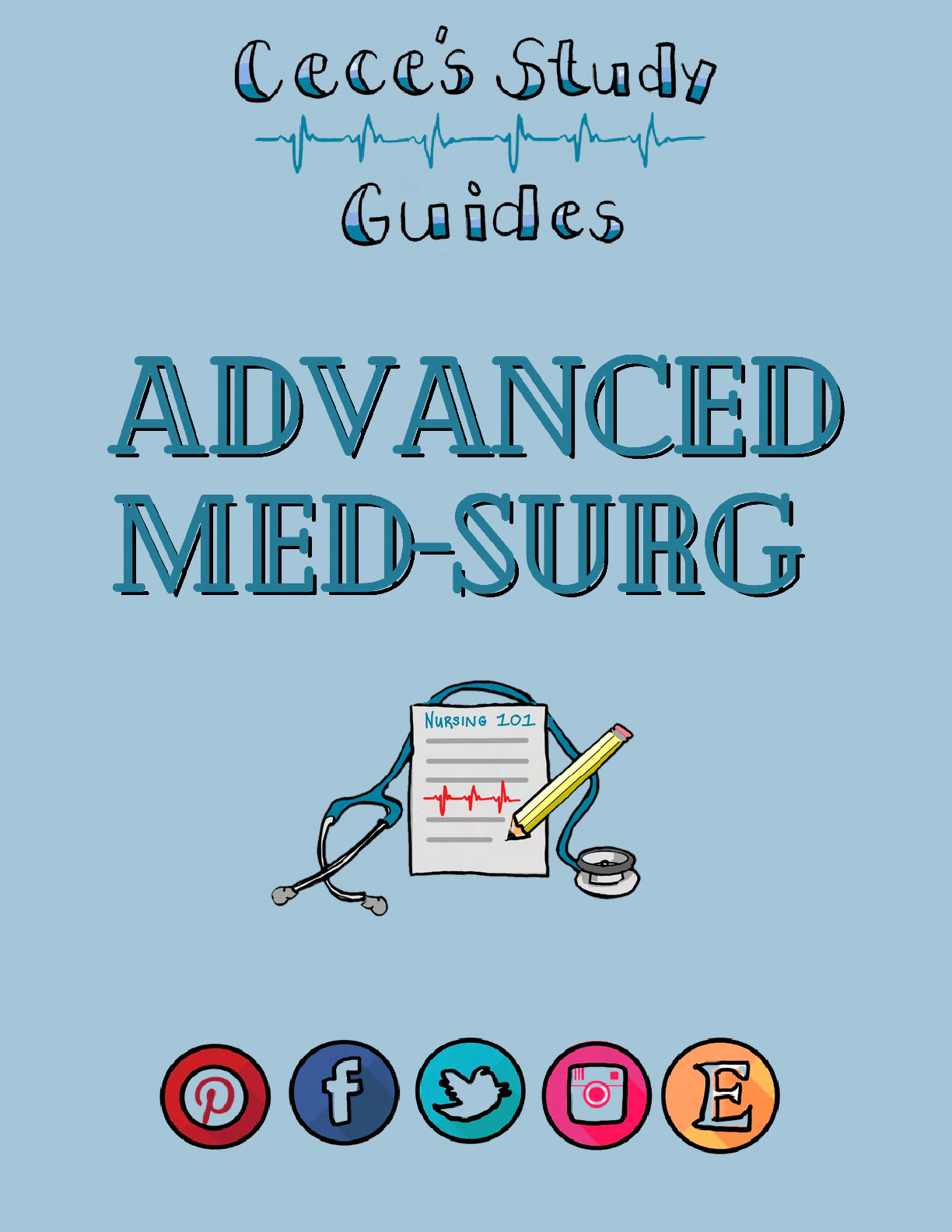*NURSING > STUDY GUIDE > Rasmussen College: NUR 2790 N3 E3 Guide 4 Latest updated 2021/2022,100% CORRECT (All)
Rasmussen College: NUR 2790 N3 E3 Guide 4 Latest updated 2021/2022,100% CORRECT
Document Content and Description Below
Rasmussen College: NUR2790 N3 E3 Guide 4 Latest updated 2021/2022 Chapter 38: Care of Patients with Acute Coronary Syndromes MULTIPLE CHOICE 1. A client is receiving an infusion of tissue plasminoge... n activator (t-PA). The nurse assesses the client to be disoriented to person, place, and time. What action by the nurse is best? c. Stop the infusion and call the provider. 2. A client received tissue plasminogen activator (t-PA) after a myocardial infarction and now is on an intravenous infusion of heparin. The clients spouse asks why the client needs this medication. What response by the nurse is best? b. The heparin keeps that artery from getting blocked again. 3. A client is in the hospital after suffering a myocardial infarction and has bathroom privileges. The nurse assists the client to the bathroom and notes the clients O2 saturation to be 95%, pulse 88 beats/min, and respiratory rate 16 breaths/min after returning to bed. What action by the nurse is best? b. Allow continued bathroom privileges. 4. A nursing student is caring for a client who had a myocardial infarction. The student is confused because the client states nothing is wrong and yet listens attentively while the student provides education on lifestyle changes and healthy menu choices. What response by the faculty member is best? a. Continue to educate the client on possible healthy changes. 5. A client undergoing hemodynamic monitoring after a myocardial infarction has a right atrial pressure of 0.5 mm Hg. What action by the nurse is most appropriate? d. Prepare to administer a fluid bolus. 6. A client has hemodynamic monitoring after a myocardial infarction. What safety precaution does the nurse implement for this client? b. Ensure the balloon does not remain wedged. 7. A client has intra-arterial blood pressure monitoring after a myocardial infarction. The nurse notes the clients heart rate has increased from 88 to 110 beats/min, and the blood pressure dropped from 120/82 to 100/60 mm Hg. What action by the nurse is most appropriate? b. Assess the client for bleeding. 8. A client is in the preoperative holding area prior to an emergency coronary artery bypass graft (CABG). The client is yelling at family members and tells the doctor to just get this over with when asked to sign the consent form. What action by the nurse is best? d. Tell the client that anxiety is common and that you can help. 9. A client is in the clinic a month after having a myocardial infarction. The client reports sleeping well since moving into the guest bedroom. What response by the nurse is best? a. Do you have any concerns about sexuality? 10. A client in the cardiac stepdown unit reports severe, crushing chest pain accompanied by nausea and vomiting. What action by the nurse takes priority? c. Maintain airway patency. 11. An older adult is on cardiac monitoring after a myocardial infarction. The client shows frequent dysrhythmias. What action by the nurse is most appropriate? a. Assess for any hemodynamic effects of the rhythm. 12. The nurse is preparing to change a clients sternal dressing. What action by the nurse is most important? d. Perform hand hygiene. 13. A client has an intra-arterial blood pressure monitoring line. The nurse notes bright red blood on the clients sheets. What action should the nurse perform first? c. Put on a pair of gloves. 14. A nurse is in charge of the coronary intensive care unit. Which client should the nurse see first? b. Client who is 1 day post coronary artery bypass graft, blood pressure 180/100 mm Hg 15. A client with coronary artery disease (CAD) asks the nurse about taking fish oil supplements. What response by the nurse is best? b. The best source is fish, but pills have benefits too. 16. A client has presented to the emergency department with an acute myocardial infarction (MI). What action by the nurse is best to meet The Joint Commissions Core Measures outcomes? b. Give the client an aspirin. 17. A nurse is caring for four clients. Which client should the nurse assess first? b. Client who is 1 hour post angioplasty, has tongue swelling and anxiety 18. A nurse is caring for a client who is intubated and has an intra-aortic balloon pump. The client is restless and agitated. What action should the nurse perform first for comfort? a. Allow family members to remain at the bedside. 19. The nurse is caring for a client with a chest tube after a coronary artery bypass graft. The drainage slows significantly. What action by the nurse is most important? b. Notify the provider immediately. 20. A home health care nurse is visiting an older client who lives alone after being discharged from the hospital after a coronary artery bypass graft. What finding in the home most causes the nurse to consider additional referrals? b. Expired food in the refrigerator 21. A client is on a dopamine infusion via a peripheral line. What action by the nurse takes priority for safety? a. Assess the IV site hourly. 22. A client had an acute myocardial infarction. What assessment finding indicates to the nurse that a significant complication has occurred? c. Poor peripheral pulses and cool skin 23. A client presents to the emergency department with an acute myocardial infarction (MI) at 1500 (3:00 PM). The facility has 24-hour catheterization laboratory abilities. To meet The Joint Commissions Core Measures set, by what time should the client have a percutaneous coronary intervention performed? c. 1630 (4:30 PM) 24. The provider requests the nurse start an infusion of an inotropic agent on a client. How does the nurse explain the action of these drugs to the client and spouse? c. It increases the force of the hearts contractions. 25. A nurse is assessing a client who had a myocardial infarction. Upon auscultating heart sounds, the nurse hears the following sound. What action by the nurse is most appropriate? (Click the media button to hear the audio clip.) d. Listen to the clients lung sounds. 26. A client had an inferior wall myocardial infarction (MI). The nurse notes the clients cardiac rhythm as shown below: What action by the nurse is most important? a. Assess the clients blood pressure and level of consciousness. MULTIPLE RESPONSE 1. A nursing student learns about modifiable risk factors for coronary artery disease. Which factors does this include? (Select all that apply.) b. Hypertension c. Obesity d. Smoking e. Stress 2. A nurse is caring for a client who had coronary artery bypass grafting yesterday. What actions does the nurse delegate to the unlicensed assistive personnel (UAP)? (Select all that apply.) a. Assist the client to the chair for meals and to the bathroom. c. Ensure the client wears TED hose or sequential compression devices. e. Take and record a full set of vital signs per hospital protocol. 3. A nursing student studying acute coronary syndromes learns that the pain of a myocardial infarction (MI) differs from stable angina in what ways? (Select all that apply.) a. Accompanied by shortness of breath b. Feelings of fear or anxiety d. No relief from taking nitroglycerin e. Pain occurs without known cause 4. A client is 1 day postoperative after a coronary artery bypass graft. What nonpharmacologic comfort measures does the nurse include when caring for this client? (Select all that apply.) b. Assist the client into a position of comfort in bed. d. Provide complementary therapies such as music. e. Remind the client to splint the incision when coughing. 5. A nursing student planning to teach clients about risk factors for coronary artery disease (CAD) would include which topics? (Select all that apply.) a. Advanced age b. Diabetes c. Ethnic background e. Smoking Chapter 45: Care of Critically Ill Patients with Neurologic Problems MULTIPLE CHOICE 1. A client is in the emergency department reporting a brief episode during which he was dizzy, unable to speak, and felt like his legs were very heavy. Currently the clients neurologic examination is normal. About what drug should the nurse plan to teach the client? b. Clopidogrel (Plavix) 2. A client had an embolic stroke and is having an echocardiogram. When the client asks why the provider ordered a test on my heart, how should the nurse respond? a. Most of these types of blood clots come from the heart. 3. A nurse receives a report on a client who had a left-sided stroke and has homonymous hemianopsia. What action by the nurse is most appropriate for this client? d. Rotate the clients meal tray when the client stops eating. 4. A client with a stroke is being evaluated for fibrinolytic therapy. What information from the client or family is most important for the nurse to obtain? d. Time of symptom onset 5. A client is being prepared for a mechanical embolectomy. What action by the nurse takes priority? b. Ensure that informed consent is on the chart. 6. A client had an embolectomy for an arteriovenous malformation (AVM). The client is now reporting a severe headache and has vomited. What action by the nurse takes priority? c. Notify the Rapid Response Team. 7. A student nurse is preparing morning medications for a client who had a stroke. The student plans to hold the docusate sodium (Colace) because the client had a large stool earlier. What action by the supervising nurse is best? b. Inform the student that the docusate should be given. 8. A client experiences impaired swallowing after a stroke and has worked with speech-language pathology on eating. What nursing assessment best indicates that a priority goal for this problem has been met? c. Has clear lung sounds on auscultation 9. A client with a stroke has damage to Brocas area. What intervention to promote communication is best for this client? a. Assess whether or not the client can write. 10. A clients mean arterial pressure is 60 mm Hg and intracranial pressure is 20 mm Hg. Based on the clients cerebral perfusion pressure, what should the nurse anticipate for this client? b. Poor prognosis and cognitive function 11. A client has a traumatic brain injury. The nurse assesses the following: pulse change from 82 to 60 beats/min, pulse pressure increase from 26 to 40 mm Hg, and respiratory irregularities. What action by the nurse takes priority? a. Call the provider or Rapid Response Team. 12. A nurse is caring for four clients in the neurologic intensive care unit. After receiving the hand-off report, which client should the nurse see first? a. Client with a Glasgow Coma Scale score that was 10 and is now is 8 13. A client is in the clinic for a follow-up visit after a moderate traumatic brain injury. The clients spouse is very frustrated, stating that the clients personality has changed and the situation is intolerable. What action by the nurse is best? a. Explain that personality changes are common following brain injuries. 14. The nurse is caring for four clients with traumatic brain injuries. Which client should the nurse assess first? d. Client who has a temperature of 102 F (38.9 C) 15. A nurse is caring for four clients who might be brain dead. Which client would best meet the criteria to allow assessment of brain death? b. Client in a coma for 2 weeks from a motor vehicle crash 16. A client with a traumatic brain injury is agitated and fighting the ventilator. What drug should the nurse prepare to administer? b. Dexmedetomidine (Precedex) 17. A client who had a severe traumatic brain injury is being discharged home, where the spouse will be a fulltime caregiver. What statement by the spouse would lead the nurse to provide further education on home care? a. I know I can take care of all these needs by myself. 18. A client in the intensive care unit is scheduled for a lumbar puncture (LP) today. On assessment, the nurse finds the client breathing irregularly with one pupil fixed and dilated. What action by the nurse is best? d. Notify the provider of the findings immediately. 19. After a craniotomy, the nurse assesses the client and finds dry, sticky mucous membranes and restlessness. The client has IV fluids running at 75 mL/hr. What action by the nurse is best? b. Assess the clients sodium level. 20. A nurse assesses a client with the National Institutes of Health (NIH) Stroke Scale and determines the clients score to be 36. How should the nurse plan care for this client? a. The client will need near-total care. 21. A client has a brain abscess and is receiving phenytoin (Dilantin). The spouse questions the use of the drug, saying the client does not have a seizure disorder. What response by the nurse is best? a. Increased pressure from the abscess can cause seizures. 22. A client has an intraventricular catheter. What action by the nurse takes priority? b. Perform hand hygiene before client care. 23. A client has a subarachnoid bolt. What action by the nurse is most important? a. Balancing and recalibrating the device 24. A nurse is providing community screening for risk factors associated with stroke. Which client would the nurse identify as being at highest risk for a stroke? a. A 27-year-old heavy cocaine user 25. A client has a shoulder injury and is scheduled for a magnetic resonance imaging (MRI). The nurse notes the presence of an aneurysm clip in the clients record. What action by the nurse is best? a. Ask the client how long ago the clip was placed. 26. A nurse is caring for four clients in the neurologic/neurosurgical intensive care unit. Which client should the nurse assess first? c. Client receiving tissue plasminogen activator (t-PA) who has a change in respiratory pattern and rate 27. The nurse assesses a clients Glasgow Coma Scale (GCS) score and determines it to be 12 (a 4 in each category). What care should the nurse anticipate for this client? c. Needs frequent re-orientation 28. After a stroke, a client has ataxia. What intervention is most appropriate to include on the clients plan of care? a. Ambulate only with a gait belt. 29. A client in the emergency department is having a stroke and needs a carotid artery angioplasty with stenting. The clients mental status is deteriorating. What action by the nurse is most appropriate? a. Attempt to find the family to sign a consent. 30. A client has a traumatic brain injury and a positive halo sign. The client is in the intensive care unit, sedated and on a ventilator, and is in critical but stable condition. What collaborative problem takes priority at this time? c. Risk for acquiring an infection MULTIPLE RESPONSE 1. A nursing student studying the neurologic system learns which information? (Select all that apply.) a. An aneurysm is a ballooning in a weakened part of an arterial wall. c. Intracerebral hemorrhage is bleeding directly into the brain. d. Reduced perfusion from vasospasm often makes stroke worse. 2. The nurse working in the emergency department assesses a client who has symptoms of stroke. For what modifiable risk factors should the nurse assess? (Select all that apply.) a. Alcohol intake c. High-fat diet d. Obesity e. Smoking 3. A nurse is caring for a client after a stroke. What actions may the nurse delegate to the unlicensed assistive personnel (UAP)? (Select all that apply.) b. Check and document oxygen saturation every 1 to 2 hours. e. Position the client supine with the head in a neutral midline position. 4. A nurse has applied to work at a hospital that has National Stroke Center designation. The nurse realizes the hospital adheres to eight Core Measures for ischemic stroke care. What do these Core Measures include? (Select all that apply.) a. Discharging the client on a statin medication d. Providing and charting stroke education e. Preventing venous thromboembolism 5. A nursing student studying traumatic brain injuries (TBIs) should recognize which facts about these disorders? (Select all that apply.) a. A client with a moderate trauma may need hospitalization. d. A client with a Glasgow Coma Scale score of 3 has severe TBI. e. The terms mild TBI and concussion have similar meanings. 6. A nurse cares for older clients who have traumatic brain injury. What should the nurse understand about this population? (Select all that apply.) a. Admission can overwhelm the coping mechanisms for older clients. c. These clients are more susceptible to systemic and wound infections. d. Other medical conditions can complicate treatment for these clients. 7. A client has meningitis following brain surgery. What comfort measures may the nurse delegate to the unlicensed assistive personnel (UAP)? (Select all that apply.) a. Applying a cool washcloth to the head b. Assisting the client to a position of comfort c. Keeping voices soft and soothing d. Maintaining low lighting in the room 8. A nurse is working with many stroke clients. Which clients would the nurse consider referring to a mental health provider on discharge? (Select all that apply.) a. Client who exhibits extreme emotional lability b. Client with an initial National Institutes of Health (NIH) Stroke Scale score of 38 d. Client who has a past hospitalization for a suicide attempt e. Client who is unable to walk or eat 3 weeks post-stroke 9. A client has a small-bore feeding tube (Dobhoff tube) inserted for continuous enteral feedings while recovering from a traumatic brain injury. What actions should the nurse include in the clients care? (Select all that apply.) a. Assess tube placement per agency policy. b. Keep the head of the bed elevated at least 30 degrees. c. Listen to lung sounds at least every 4 hours. d. Run continuous feedings on a feeding pump. 10. A nurse is seeing many clients in the neurosurgical clinic. With which clients should the nurse plan to do more teaching? (Select all that apply.) a. Client with an aneurysm coil placed 2 months ago who is taking ibuprofen (Motrin) for sinus headaches b. Client with an aneurysm clip who states that his family is happy there is no chance of recurrence 11. A nurse is dismissing a client from the emergency department who has a mild traumatic brain injury. What information obtained from the client represents a possible barrier to self-management? (Select all that apply.) b. Is allergic to acetaminophen (Tylenol) d. Lives alone and is new in town with no friends e. Plans to have a beer and go to bed once home SHORT ANSWER 1. A client in the emergency department is having a stroke and the provider has prescribed the tissue plasminogen activator (t-PA) alteplase (Activase). The client weighs 146 pounds. How much medication will this client receive? (Record your answer using a whole number.) mg 60 mg 2. A client in the emergency department is having a stroke. The client weighs 225 pounds. After the initial bolus of t-Pa, at what rate should the nurse set the IV pump? (Record your answer using a decimal rounded to the nearest tenth.) mL/hr 1.4 mL/hr Chapter 58: Care of Patients with Liver Problems MULTIPLE CHOICE 1. A nurse obtains a clients health history at a community health clinic. Which statement alerts the nurse to provide health teaching to this client? b. I take a lot of Tylenol for my arthritis pain. 2. A nurse cares for a client who has cirrhosis of the liver. Which action should the nurse take to decrease the presence of ascites? b. Provide a low-sodium diet. 3. A nurse assesses a client who is recovering from a paracentesis 1 hour ago. Which assessment finding requires action by the nurse? a. Urine output via indwelling urinary catheter is 20 mL/hr 4. A nurse cares for a client who is hemorrhaging from bleeding esophageal varices and has an esophagogastric tube. Which action should the nurse take first? d. Assess the client for airway patency. 5. A nurse assesses a client who is prescribed an infusion of vasopressin (Pitressin) for bleeding esophageal varices. Which clinical manifestation should alert the nurse to a serious adverse effect? d. Mid-sternal chest pain 6. A nurse cares for a client with hepatic portal-systemic encephalopathy (PSE). The client is thin and cachectic in appearance, and the family expresses distress that the client is receiving little dietary protein. How should the nurse respond? b. Less protein in the diet will help prevent confusion associated with liver failure. 7. A nurse cares for a client who is prescribed lactulose (Heptalac). The client states, I do not want to take this medication because it causes diarrhea. How should the nurse respond? a. Diarrhea is expected; thats how your body gets rid of ammonia. 8. After teaching a client who has been diagnosed with hepatitis A, the nurse assesses the clients understanding. Which statement by the client indicates a correct understanding of the teaching? b. I may have been exposed when we ate shrimp last weekend. 9. A nurse assesses clients at a community health fair. Which client is at greatest risk for the development of hepatitis B? a. A 20-year-old college student who has had several sexual partners 10. A nurse teaches a client with hepatitis C who is prescribed ribavirin (Copegus). Which statement should the nurse include in this clients discharge education? a. Use a pill organizer to ensure you take this medication as prescribed. 11. After teaching a client who has plans to travel to a non-industrialized country, the nurse assesses the clients understanding regarding the prevention of viral hepatitis. Which statement made by the client indicates a need for additional teaching? c. I should eat plenty of fresh fruits and vegetables. 12. An emergency room nurse assesses a client after a motor vehicle crash. The nurse notices a steering wheel mark across the clients chest. Which action should the nurse take? b. Assess the client by gently palpating the abdomen for tenderness. 13. A nurse assesses clients on the medical-surgical unit. Which client is at greatest risk for the development of carcinoma of the liver? c. A 66-year-old who has a history of cirrhosis 14. A telehealth nurse speaks with a client who is recovering from a liver transplant 2 weeks ago. The client states, I am experiencing right flank pain and have a temperature of 101 F. How should the nurse respond? b. You should go to the hospital immediately to have your new liver checked out. 15. After teaching a client who has alcohol-induced cirrhosis, a nurse assesses the clients understanding. Which statement made by the client indicates a need for additional teaching? b. I need to avoid protein in my diet. 16. A nurse cares for a client with hepatopulmonary syndrome who is experiencing dyspnea with oxygen saturations at 92%. The client states, I do not want to wear the oxygen because it causes my nose to bleed. Get out of my room and leave me alone! Which action should the nurse take? a. Instruct the client to sit in as upright a position as possible. 17. A nurse cares for a client who is scheduled for a paracentesis. Which intervention should the nurse delegate to an unlicensed assistive personnel (UAP)? b. Assist the client to void before the procedure. 18. A nurse cares for a client who has chronic cirrhosis from substance abuse. The client states, All of my family hates me. How should the nurse respond? c. I will help you identify a support system. 19. A nurse cares for a client with hepatitis C. The clients brother states, I do not want to contract this infection, so I will not go into his hospital room. How should the nurse respond? b. Viral hepatitis is not spread through casual contact. MULTIPLE RESPONSE 1. An infection control nurse develops a plan to decrease the number of health care professionals who contract viral hepatitis at work. Which ideas should the nurse include in this plan? (Select all that apply.) a. Policies related to consistent use of Standard Precautions c. Implementation of a needleless system for intravenous therapy d. Number of sharps used in client care reduced where possible e. Postexposure prophylaxis provided in a timely manner 2. A nurse assesses a client who has liver disease. Which laboratory findings should the nurse recognize as potentially causing complications of this disorder? (Select all that apply.) b. Elevated international normalized ratio (INR) e. Elevated serum ammonia f. Elevated prothrombin time (PT) 3. A nurse delegates hygiene care for a client who has advanced cirrhosis to an unlicensed nursing personnel (UAP). Which statements should the nurse include when delegating this task to the UAP? (Select all that apply.) a. Apply lotion to the clients dry skin areas. c. For the clients oral care, use a soft toothbrush. d. Provide clippers so the client can trim the fingernails. 4. A nurse assesses a male client who has symptoms of cirrhosis. Which questions should the nurse ask to identify potential factors contributing to this laboratory result? (Select all that apply.) Test Bank - Medical-Surgical Nursing: Concepts for Interprofessional Collaborative Care 9e 487 a. How frequently do you drink alcohol? b. Have you ever had sex with a man? e. Were you previously incarcerated? 5. A nurse plans care for a client who has hepatopulmonary syndrome. Which interventions should the nurse include in this clients plan of care? (Select all that apply.) a. Oxygen therapy c. Feet elevated on pillows d. Daily weights 6. An emergency room nurse assesses a client with potential liver trauma. Which clinical manifestations should alert the nurse to internal bleeding and hypovolemic shock? (Select all that apply.) b. Tachycardia d. Confusion Chapter 59: Care of Patients with Problems of the Biliary System and Pancreas MULTIPLE CHOICE 1. A nurse cares for a client who has obstructive jaundice. The client asks, Why is my skin so itchy? How should the nurse respond? a. Bile salts accumulate in the skin and cause the itching. 2. After teaching a client who is recovering from laparoscopic cholecystectomy surgery, the nurse assesses the clients understanding. Which statement made by the client indicates a correct understanding of the teaching? b. I will decrease the amount of fatty foods in my diet. 3. A nurse cares for a client who is recovering from laparoscopic cholecystectomy surgery. The client reports pain in the shoulder blades. How should the nurse respond? a. Ambulating in the hallway twice a day will help. 4. After teaching a client who has a history of cholelithiasis, the nurse assesses the clients understanding. Which menu selection made by the client indicates the client clearly understands the dietary teaching? d. Roasted chicken breast, baked potato with chives, and orange juice 5. A nurse plans care for a client with acute pancreatitis. Which intervention should the nurse include in this clients plan of care to reduce discomfort? b. Maintain nothing by mouth (NPO) and administer intravenous fluids. 6. After teaching a client who is prescribed pancreatic enzyme replacement therapy, the nurse assesses the clients understanding. Which statement made by the client indicates a need for additional teaching? c. The best time to take the enzymes is immediately after I have a meal or a snack. 7. A nurse assesses a client who is recovering from an open Whipple procedure. Which action should the nurse perform first? a. Assess the clients endotracheal tube with 40% FiO2. 8. A nurse cares for a client with end-stage pancreatic cancer. The client asks, Why is this happening to me? How should the nurse respond? a. I dont know. I wish I had an answer for you, but I dont. 9. A nurse prepares to assess the emotional state of a client with end-stage pancreatic cancer. Which action should the nurse take first? c. Determine whether the client feels like talking about his or her feelings. 10. A nurse assesses clients at a community health center. Which client is at highest risk for pancreatic cancer? c. A 50-year-old who has the BRCA2 gene mutation 11. A nurse assesses a client who has cholecystitis. Which clinical manifestation indicates that the condition is chronic rather than acute? c. Light-colored stools 12. A nurse cares for a client who is prescribed patient-controlled analgesia (PCA) after a cholecystectomy. The client states, When I wake up I am in pain. Which action should the nurse take? b. Encourage the client to use the PCA pump upon awakening. 13. A nurse cares for a client with acute pancreatitis. The client states, I am hungry. How should the nurse reply? c. Have you passed any flatus or moved your bowels? 14. A nurse prepares to discharge a client with chronic pancreatitis. Which question should the nurse ask to ensure safety upon discharge? a. Do you have a one- or two-story home? 15. A nurse assesses clients on the medical-surgical unit. Which client should the nurse identify as at high risk for pancreatic cancer? d. A 66-year-old who smokes cigarettes 16. A nurse assesses a client who is recovering from a Whipple procedure. Which assessment finding alerts the nurse to urgently contact the health care provider? a. Drainage from a fistula 17. A nurse cares for a client who is recovering from an open Whipple procedure. Which action should the nurse take? b. Place the client in semi-Fowlers position. MULTIPLE RESPONSE 1. A nurse assesses a client who is recovering from a Whipple procedure. Which clinical manifestations alert the nurse to a complication from this procedure? (Select all that apply.) b. Substernal chest pain c. Shortness of breath d. Lack of bowel sounds or flatus e. Urine output of 20 mL/6 hr 2. A nurse assesses a client with cholelithiasis. Which assessment findings should the nurse identify as contributors to this clients condition? (Select all that apply.) a. Body mass index of 46 d. Pregnant with twins f. Glycosylated hemoglobin level of 15% 3. A nurse teaches a client who is recovering from acute pancreatitis. Which statements should the nurse include in this clients teaching? (Select all that apply.) b. Attend local Alcoholics Anonymous (AA) meetings weekly. d. Use cooking spray when you cook rather than margarine or butter. f. We can talk to your doctor about a prescription for nicotine patches. 4. A nurse cares for a client who presents with tachycardia and prostration related to biliary colic. Which actions should the nurse take? (Select all that apply.) a. Contact the provider immediately. b. Lower the head of the bed. 5. A nurse plans care for a client who has acute pancreatitis and is prescribed nothing by mouth (NPO). With which health care team members should the nurse collaborate to provide appropriate nutrition to this client? (Select all that apply.) a. Registered dietitian c. Clinical pharmacist e. Health care provider 6. A nurse collaborates with an unlicensed assistive personnel (UAP) to provide care for a client who is in the healing phase of acute pancreatitis. Which statements focused on nutritional requirements should the nurse include when delegating care for this client? (Select all that apply.) b. Make sure the client receives a protein shake. c. Do not allow caffeine-containing beverages. d. Make sure the foods are bland with little spice. 7. A nurse cares for a client with pancreatic cancer who is prescribed implanted radioactive iodine seeds. Which actions should the nurse take when caring for this client? (Select all that apply.) b. Place the client in a private room. c. Wear a lead apron when providing client care. d. Bundle care to minimize exposure to the client. SHORT ANSWER 1. A nurse cares for a client with acute pancreatitis who is prescribed gentamicin (Garamycin) 3 mg/kg/day in 3 divided doses. The client weighs 264 lb. How many milligrams should the nurse administer for each dose? (Record your answer using a whole number.) mg/dose 120 mg/dose 2. A nurse cares for a client who is prescribed 4 mg of calcium gluconate to infuse over 5 hours. The pharmacy provides 2 premixed infusion bags with 2 mg of calcium gluconate in 100 mL of D5W. At what rate should the nurse administer this medication? (Record your answer using a whole number.) mL/hr 40 mL/hr Chapter 61: Assessment of the Endocrine System MULTIPLE CHOICE 1. A nurse cares for a client who is prescribed a drug that blocks a hormones receptor site. Which therapeutic effect should the nurse expect? b. Decreased hormone activity 2. A nurse cares for a client with a deficiency of aldosterone. Which assessment finding should the nurse correlate with this deficiency? a. Increased urine output 3. A nurse cares for a client with excessive production of thyrocalcitonin (calcitonin). For which electrolyte imbalance should the nurse assess? c. Calcium 4. A nurse assesses a client who is prescribed a medication that stimulates beta1 receptors. Which assessment finding should alert the nurse to urgently contact the health care provider? a. Heart rate of 50 beats/min 5. A nurse prepares to palpate a clients thyroid gland. Which action should the nurse take when performing this assessment? d. Place the client in a sitting position with the chin tucked down. 6. A nurse collaborates with an unlicensed assistive personnel (UAP) to provide care for a client who is prescribed a 24-hour urine specimen collection. Which statement should the nurse include when delegating this activity to the UAP? a. Note the time of the clients first void and collect urine for 24 hours. 7. A nurse assesses a female client who presents with hirsutism. Which question should the nurse ask when assessing this client? b. How do you feel about yourself? 8. A nurse teaches a client who has been prescribed a 24-hour urine collection to measure excreted hormones. The client asks, Why do I need to collect urine for 24 hours instead of providing a random specimen? How should the nurse respond? a. This test will assess for a hormone secreted on a circadian rhythm. 9. A nurse plans care for an older adult who is admitted to the hospital for pneumonia. The client has no known drug allergies and no significant health history. Which action should the nurse include in this clients plan of care? b. Offer fluids every hour or two. 10. A nurse cares for a client who is prescribed a 24-hour urine collection. The unlicensed assistive personnel (UAP) reports that, while pouring urine into the collection container, some urine splashed his hand. Which action should the nurse take next? a. Ask the UAP if he washed his hands afterward. 11. A nurse evaluates laboratory results for a male client who reports fluid secretion from his breasts. Which hormone value should the nurse assess first? c. Anterior pituitary hormones 12. A nurse cares for a client who has excessive catecholamine release. Which assessment finding should the nurse correlate with this condition? b. Increased pulse 13. A nurse assesses a client diagnosed with adrenal hypofunction. Which client statement should the nurse correlate with this diagnosis? a. I have a terrible craving for potato chips. 14. A nurse teaches an older adult with a decreased production of estrogen. Which statement should the nurse include in this clients teaching to decrease injury? b. Walk around the neighborhood for daily exercise. 15. A nurse cares for a client who is prescribed a serum catecholamine test. Which action should the nurse take when obtaining the sample? c. Place the sample on ice and send to the laboratory immediately. MULTIPLE RESPONSE 1. A nurse cares for clients with hormone disorders. Which are common key features of hormones? (Select all that apply.) a. Hormones may travel long distances to get to their target tissues. b. Continued hormone activity requires continued production and secretion. c. Control of hormone activity is caused by negative feedback mechanisms. 2. A nurse cares for a client with a hypofunctioning anterior pituitary gland. Which hormones should the nurse expect to be affected by this condition? (Select all that apply.) a. Thyroid-stimulating hormone c. Follicle-stimulating hormone e. Growth hormone 3. A nurse assesses clients who have endocrine disorders. Which assessment findings are paired correctly with the endocrine disorder? (Select all that apply.) a. Excessive thyroid-stimulating hormone Increased bone formation b. Excessive melanocyte-stimulating hormone Darkening of the skin Chapter 62: Care of Patients with Pituitary and Adrenal Gland Problems MULTIPLE CHOICE 1. A nurse assesses clients for potential endocrine dysfunction. Which client is at greatest risk for a deficiency of gonadotropin and growth hormone? b. A 42-year-old male who experienced head trauma 3 years ago 2. A nurse plans care for a client with a growth hormone deficiency. Which action should the nurse include in this clients plan of care? c. Use a lift sheet to re-position the client. 3. A nurse cares for a male client with hypopituitarism who is prescribed testosterone hormone replacement therapy. The client asks, How long will I need to take this medication? How should the nurse respond? b. When your beard thickens and your voice deepens, the dose is decreased, but treatment will continue forever. 4. A nurse cares for a client after a pituitary gland stimulation test using insulin. The clients post-stimulation laboratory results indicate elevated levels of growth hormone (GH) and adrenocorticotropic hormone (ACTH). How should the nurse interpret these results? d. Normal pituitary response to insulin 5. After teaching a client with acromegaly who is scheduled for a hypophysectomy, the nurse assesses the clients understanding. Which statement made by the client indicates a need for additional teaching? c. I hope I can go back to wearing size 8 shoes instead of size 12. 6. A nurse assesses a client who is recovering from a transsphenoidal hypophysectomy. The nurse notes nuchal rigidity. Which action should the nurse take first? c. Take vital signs, including temperature. 7. After teaching a client who is recovering from an endoscopic trans-nasal hypophysectomy, the nurse assesses the clients understanding. Which statement made by the client indicates a correct understanding of the teaching? b. Ill keep food on upper shelves so I do not have to bend over. 8. A nurse cares for a client who possibly has syndrome of inappropriate antidiuretic hormone (SIADH). The clients serum sodium level is 114 mEq/L. Which action should the nurse take first? b. Restrict the clients fluid intake to 600 mL/day. 9. A nurse plans care for a client with Cushings disease. Which action should the nurse include in this clients plan of care to prevent injury? c. Use a lift sheet to change the clients position. 10. A nurse is caring for a client who was prescribed high-dose corticosteroid therapy for 1 month to treat a severe inflammatory condition. The clients symptoms have now resolved and the client asks, When can I stop taking these medications? How should the nurse respond? b. Once you start corticosteroids, you have to be weaned off them. 11. A nurse cares for a client with adrenal hyperfunction. The client screams at her husband, bursts into tears, and throws her water pitcher against the wall. She then tells the nurse, I feel like I am going crazy. How should the nurse respond? b. You feel this way because of your hormone levels. 12. A client with hyperaldosteronism is being treated with spironolactone (Aldactone) before surgery. Which precautions does the nurse teach this client? a. Read the label before using salt substitutes. 13. A nurse cares for a client with chronic hypercortisolism. Which action should the nurse take? a. Wash hands when entering the room. 14. A nurse cares for a client who is recovering from a hypophysectomy. Which action should the nurse take first? c. Report clear or light yellow drainage from the nose. 15. A nurse teaches a client with a cortisol deficiency who is prescribed prednisone (Deltasone). Which statement should the nurse include in this clients instructions? b. If you work outside in the heat, you may need another drug. 16. An emergency nurse cares for a client who is experiencing an acute adrenal crisis. Which action should the nurse take first? a. Obtain intravenous access. MULTIPLE RESPONSE 1. A nurse assesses a client with anterior pituitary hyperfunction. Which clinical manifestations should the nurse expect? (Select all that apply.) a. Protrusion of the lower jaw c. Enlarged hands and feet d. Kyphosis e. Barrel-shaped chest f. Excessive sweating 2. A nurse assesses clients with potential endocrine disorders. Which clients are at high risk for hypopituitarism? (Select all that apply.) a. A 20-year-old female with benign pituitary tumors c. A 41-year-old female with anorexia nervosa d. A 55-year-old male with hypertension e. A 60-year-old female who is experiencing shock 3. A nurse assesses a client who potentially has hyperaldosteronism. Which serum laboratory values should the nurse associate with this disorder? (Select all that apply.) a. Sodium: 150 mEq/L c. Potassium: 2.5 mEq/L e. pH: 7.28 4. A nurse teaches a client with Cushings disease. Which dietary requirements should the nurse include in this clients teaching? (Select all that apply.) b. Low carbohydrate d. Low calories e. Low sodium 5. A nurse cares for a client who is prescribed vasopressin (DDAVP) for diabetes insipidus. Which assessment findings indicate a therapeutic response to this therapy? (Select all that apply.) a. Urine output is increased. d. Specific gravity is decreased. f. Urine osmolality is decreased. 6. A nurse assesses clients with potential endocrine disorders. Which clients are at high risk for adrenal insufficiency? (Select all that apply.) a. A 22-year-old female with metastatic cancer b. A 43-year-old male with tuberculosis d. A 65-year-old male with gram-negative sepsis 7. A nurse assesses a client with Cushings disease. Which assessment findings should the nurse correlate with this disorder? (Select all that apply.) a. Moon face d. Petechiae e. Muscle atrophy Chapter 63: Care of Patients with Problems of the Thyroid and Parathyroid Glands MULTIPLE CHOICE 1. A nurse assesses a client with hyperthyroidism who is prescribed lithium carbonate. Which assessment finding should alert the nurse to a side effect of this therapy? b. Increased thirst and urination 2. A nurse assesses a client who is recovering from a total thyroidectomy and notes the development of stridor. Which action should the nurse take first? d. Contact the provider and prepare for intubation. 3. A nurse assesses a client who is recovering from a subtotal thyroidectomy. On the second postoperative day the client states, I feel numbness and tingling around my mouth. What action should the nurse take? c. Assess for Chvosteks sign. 4. A nurse assesses a client on the medical-surgical unit. Which statement made by the client should alert the nurse to the possibility of hypothyroidism? d. I am always tired, even with 12 hours of sleep. 5. A nurse cares for a client who presents with bradycardia secondary to hypothyroidism. Which medication should the nurse anticipate being prescribed to the client? b. Levothyroxine sodium (Synthroid) 6. A nurse plans care for a client with hypothyroidism. Which priority problem should the nurse plan to address first for this client? c. Depression and withdrawal 7. A nurse assesses a client who is prescribed levothyroxine (Synthroid) for hypothyroidism. Which assessment finding should alert the nurse that the medication therapy is effective? d. Heart rate is 70 beats/min and regular. 8. A nurse cares for a client who has hypothyroidism as a result of Hashimotos thyroiditis. The client asks, How long will I need to take this thyroid medication? How should the nurse respond? c. Youll need thyroid pills for life because your thyroid wont start working again. 9. A nurse assesses clients for potential endocrine disorders. Which client is at greatest risk for hyperparathyroidism? b. A 41-year-old male receiving dialysis for end-stage kidney disease 10. A nurse plans care for a client with hyperparathyroidism. Which intervention should the nurse include in this clients plan of care? b. Use a lift sheet to assist the client with position changes. 11. A nurse cares for a client who is recovering from a parathyroidectomy. When taking the clients blood pressure, the nurse notes that the clients hand has gone into flexion contractions. Which laboratory result does the nurse correlate with this condition? d. Serum calcium: 6.9 mg/dL 12. A nurse cares for a client newly diagnosed with Graves disease. The clients mother asks, I have diabetes mellitus. Am I responsible for my daughters disease? How should the nurse respond? b. An association has been noted between Graves disease and diabetes, but the fact that you have diabetes did not cause your daughter to have Graves disease. 13. While assessing a client with Graves disease, the nurse notes that the clients temperature has risen 1 F. Which action should the nurse take first? a. Turn the lights down and shut the clients door. 14. After teaching a client who is recovering from a complete thyroidectomy, the nurse assesses the clients understanding. Which statement made by the client indicates a need for additional instruction? b. After surgery, I wont need to take thyroid medication. 15. A nurse plans care for a client who has hypothyroidism and is admitted for pneumonia. Which priority intervention should the nurse include in this clients plan of care? c. Ensure that working suction equipment is in the room. MULTIPLE RESPONSE 1. A nurse evaluates the following laboratory results for a client who has hypoparathyroidism: Calcium 7.2 mg/dL Sodium 144 mEq/L Magnesium 1.2 mEq/L Potassium 5.7 mEq/L Based on these results, which medications should the nurse anticipate administering? (Select all that apply.) b. Intravenous calcium chloride d. 50% magnesium sulfate 2. A nurse cares for a client with elevated triiodothyronine and thyroxine, and normal thyroid-stimulating hormone levels. Which actions should the nurse take? (Select all that apply.) c. Monitor the apical pulse. e. Initiate telemetry monitoring. 3. A nurse teaches a client with hyperthyroidism. Which dietary modifications should the nurse include in this clients teaching? (Select all that apply.) a. Increased carbohydrates c. Increased calorie intake e. Increased proteins 4. A nurse assesses a client with hypothyroidism who is admitted with acute appendicitis. The nurse notes that the clients level of consciousness has decreased. Which actions should the nurse take? (Select all that apply.) a. Infuse intravenous fluids. b. Cover the client with warm blankets. d. Maintain a patent airway. 5. A nurse teaches a client who is prescribed an unsealed radioactive isotope. Which statements should the nurse include in this clients education? (Select all that apply.) a. Do not share utensils, plates, and cups with anyone else. d. Wash your clothing separate from others in the household. e. Take a laxative 2 days after therapy to excrete the radiation. Chapter 68: Care of Patients with Acute Kidney Injury and Chronic Kidney Disease MULTIPLE CHOICE 1. The nurse is assessing a client with a diagnosis of pre-renal acute kidney injury (AKI). Which condition would the nurse expect to find in the clients recent history? b. Myocardial infarction 2. A marathon runner comes into the clinic and states I have not urinated very much in the last few days. The nurse notes a heart rate of 110 beats/min and a blood pressure of 86/58 mm Hg. Which action by the nurse is the priority? a. Give the client a bottle of water immediately. 3. A male client comes into the emergency department with a serum creatinine of 2.2 mg/dL and a blood urea nitrogen (BUN) of 24 mL/dL. What question should the nurse ask first when taking this clients history? a. Have you been taking any aspirin, ibuprofen, or naproxen recently? 4. A client is admitted with acute kidney injury (AKI) and a urine output of 2000 mL/day. What is the major concern of the nurse regarding this clients care? b. Electrolyte and fluid imbalance 5. A client with acute kidney injury has a blood pressure of 76/55 mm Hg. The health care provider ordered 1000 mL of normal saline to be infused over 1 hour to maintain perfusion. The client is starting to develop shortness of breath. What is the nurses priority action? d. Slow down the normal saline infusion. 6. A client has a serum potassium level of 6.5 mmol/L, a serum creatinine level of 2 mg/dL, and a urine output of 350 mL/day. What is the best action by the nurse? a. Place the client on a cardiac monitor immediately. 7. A client has just had a central line catheter placed that is specific for hemodialysis. What is the most appropriate action by the nurse? d. Place a heparin or heparin/saline dwell after hemodialysis. 8. A client in the intensive care unit is started on continuous venovenous hemofiltration (CVVH). Which finding is the cause of immediate action by the nurse? a. Blood pressure of 76/58 mm Hg 9. The nurse is caring for four clients with chronic kidney disease. Which client should the nurse assess first upon initial rounding? b. Client with Kussmaul respirations 10. The charge nurse of the medical-surgical unit is making staff assignments. Which staff member should be assigned to a client with chronic kidney disease who is exhibiting a low-grade fever and a pericardial friction rub? c. Registered nurse who was assigned the same client yesterday 11. A male client with chronic kidney disease (CKD) is refusing to take his medication and has missed two hemodialysis appointments. What is the best initial action for the nurse? a. Discuss what the treatment regimen means to him. 12. A client is taking furosemide (Lasix) 40 mg/day for management of chronic kidney disease (CKD). To detect the positive effect of the medication, what action of the nurse is best? a. Obtain daily weights of the client. 13. A client is diagnosed with chronic kidney disease (CKD). What is an ideal goal of treatment set by the nurse in the care plan to reduce the risk of pulmonary edema? c. Maintaining a balanced intake and output 14. A client has a long history of hypertension. Which category of medications would the nurse expect to be ordered to avoid chronic kidney disease (CKD)? d. Angiotensin-converting enzyme (ACE) inhibitor 15. A 70-kg adult with chronic renal failure is on a 40-g protein diet. The client has a reduced glomerular filtration rate and is not undergoing dialysis. Which result would give the nurse the most concern? a. Albumin level of 2.5 g/dL 16. The nurse is teaching a client with chronic kidney disease (CKD) about the sodium restriction needed in the diet to prevent edema and hypertension. Which statement by the client indicates more teaching is needed? a. I am thrilled that I can continue to eat fast food. 17. A client is placed on fluid restrictions because of chronic kidney disease (CKD). Which assessment finding would alert the nurse that the clients fluid balance is stable at this time? c. No adventitious sounds in the lungs 18. A client with chronic kidney disease (CKD) is experiencing nausea, vomiting, visual changes, and anorexia. Which action by the nurse is best? a. Check the clients digoxin (Lanoxin) level. 19. The nurse is taking the vital signs of a client after hemodialysis. Blood pressure is 110/58 mm Hg, pulse 66 beats/min, and temperature is 99.8 F (37.6 C). What is the most appropriate action by the nurse? c. Monitor the clients temperature. 20. The nurse is teaching the main principles of hemodialysis to a client with chronic kidney disease. Which statement by the client indicates a need for further teaching by the nurse? b. Dialysis works by movement of wastes from lower to higher concentration. 21. The charge nurse is orienting a float nurse to an assigned client with an arteriovenous (AV) fistula for hemodialysis in her left arm. Which action by the float nurse would be considered unsafe? c. Administering intravenous fluids through the AV fistula 22. A client is assessed by the nurse after a hemodialysis session. The nurse notes bleeding from the clients nose and around the intravenous catheter. What action by the nurse is the priority? d. Prepare protamine sulfate for administration. 23. A nurse is caring for a client who is scheduled for a dose of cefazolin and vitamins at this time. Hemodialysis for this client is also scheduled in 60 minutes. Which action by the nurse is best? d. Hold all medications since both cefazolin and vitamins are dialyzable. 24. A client is having a peritoneal dialysis treatment. The nurse notes an opaque color to the effluent. What is the priority action by the nurse? b. Take a sample of the effluent and send to the laboratory. 25. The nurse is teaching a client how to increase the flow of dialysate into the peritoneal cavity during dialysis. Which statement by the client demonstrates a correct understanding of the teaching? c. I should take a stool softener every morning to avoid constipation. 26. A client with chronic kidney disease states, I feel chained to the hemodialysis machine. What is the nurses best response to the clients statement? d. Tell me more about your feelings regarding hemodialysis treatment. 27. A client is recovering from a kidney transplant. The clients urine output was 1500 mL over the last 12-hour period since transplantation. What is the priority assessment by the nurse? b. Taking blood pressure 28. A nurse reviews these laboratory values of a client who returned from kidney transplantation 12 hours ago: Sodium 136 mEq/L Potassium 5 mEq/L Blood urea nitrogen (BUN) 44 mg/dL Serum creatinine 2.5 mg/dL What initial intervention would the nurse anticipate? c. Increase the dose of immunosuppression. MULTIPLE RESPONSE 1. The nurse is caring for five clients on the medical-surgical unit. Which clients would the nurse consider to be at risk for post-renal acute kidney injury (AKI)? (Select all that apply.) a. Man with prostate cancer b. Woman with blood clots in the urinary tract c. Client with ureterolithiasis 2. A nurse is caring for a postoperative 70-kg client who had major blood loss during surgery. Which findings by the nurse should prompt immediate action to prevent acute kidney injury? (Select all that apply.) a. Urine output of 100 mL in 4 hours c. Large amount of sediment in the urine e. Blood pressure of 90/60 mm Hg 3. A client is hospitalized in the oliguric phase of acute kidney injury (AKI) and is receiving tube feedings. The nurse is teaching the clients spouse about the kidney-specific formulation for the enteral solution compared to standard formulas. What components should be discussed in the teaching plan? (Select all that apply.) a. Lower sodium c. Lower potassium e. Higher calories 4. The nurse is teaching a client with diabetes mellitus how to prevent or delay chronic kidney disease (CKD). Which client statements indicate a lack of understanding of the teaching? (Select all that apply.) b. My weight should be maintained at a body mass index of 30. d. I can continue to take an aspirin every 4 to 8 hours for my pain. e. I really only need to drink a couple of glasses of water each day. 5. A nurse is giving discharge instructions to a client recently diagnosed with chronic kidney disease (CKD). Which statements made by the client indicate a correct understanding of the teaching? (Select all that apply.) b. I need to ask for an antibiotic when scheduling a dental appointment. c. Ill need to check my blood sugar often to prevent hypoglycemia. d. The dose of my pain medication may have to be adjusted. e. I should watch for bleeding when taking my anticoagulants. 6. A client is undergoing hemodialysis. The clients blood pressure at the beginning of the procedure was 136/88 mm Hg, and now it is 110/54 mm Hg. What actions should the nurse perform to maintain blood pressure? (Select all that apply.) a. Adjust the rate of extracorporeal blood flow. b. Place the client in the Trendelenburg position. d. Administer a 250-mL bolus of normal saline. 7. A client is unsure of the decision to undergo peritoneal dialysis (PD) and wishes to discuss the advantages of this treatment with the nurse. Which statements by the nurse are accurate regarding PD? (Select all that apply.) a. You will not need vascular access to perform PD. b. There is less restriction of protein and fluids. d. You have flexible scheduling for the exchanges. SHORT ANSWER 1. A client in the intensive care unit with acute kidney injury (AKI) must maintain a mean arterial pressure (MAP) of 65 mm Hg to promote kidney perfusion. What is the clients MAP if the blood pressure is 98/50 mm Hg? (Record your answer using a whole number.) mm Hg 66 mm Hg [Show More]
Last updated: 1 year ago
Preview 1 out of 39 pages
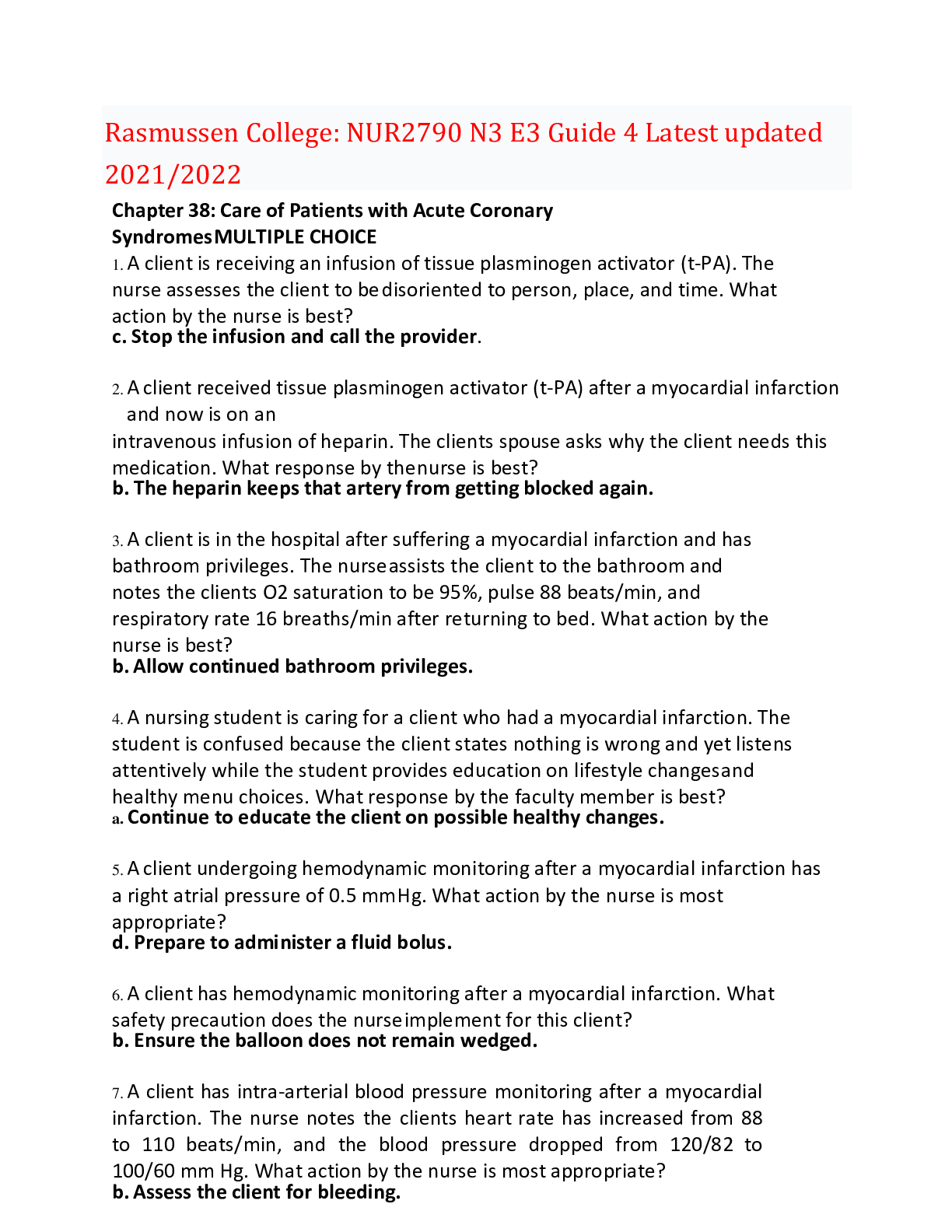
Reviews( 0 )
Document information
Connected school, study & course
About the document
Uploaded On
Jul 23, 2022
Number of pages
39
Written in
Additional information
This document has been written for:
Uploaded
Jul 23, 2022
Downloads
0
Views
79

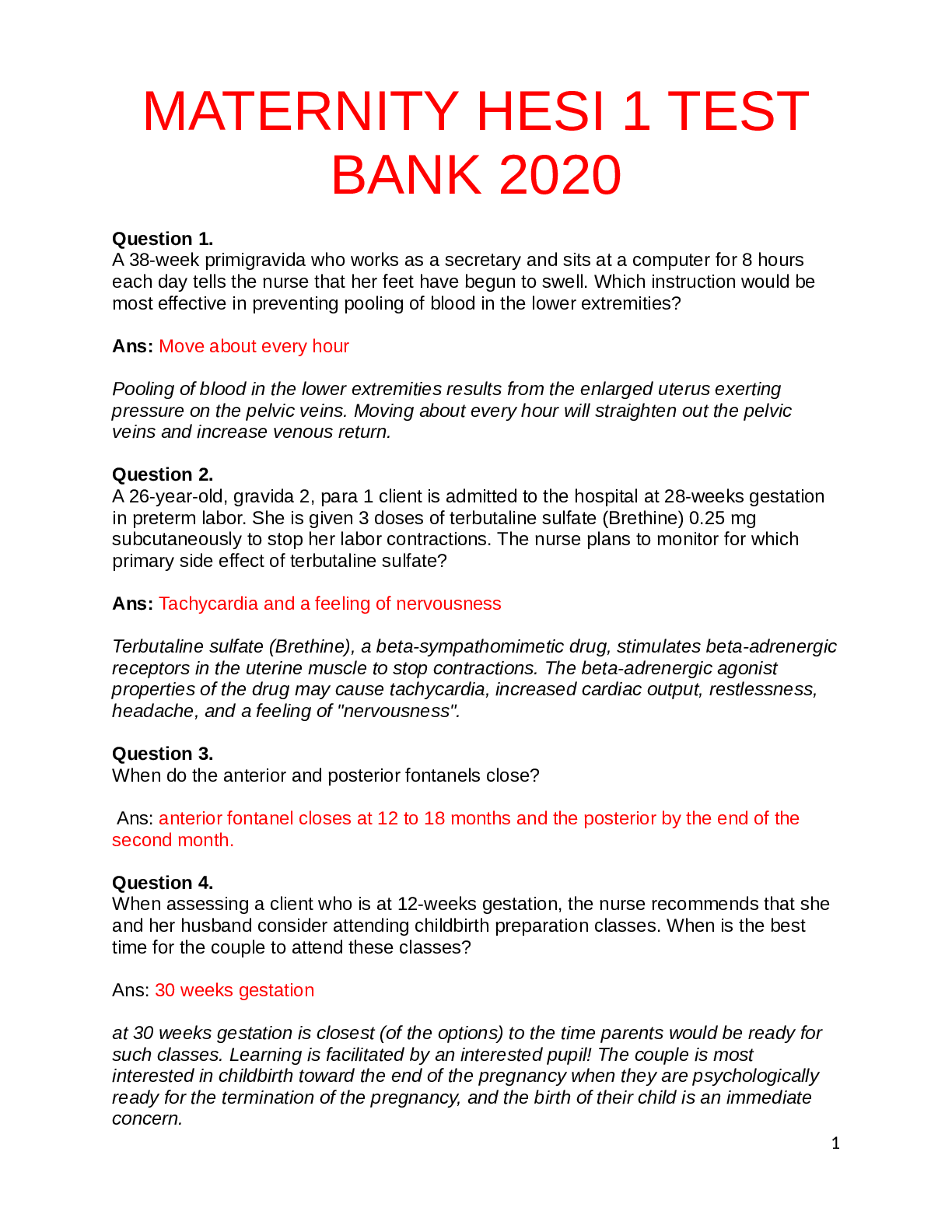
.png)
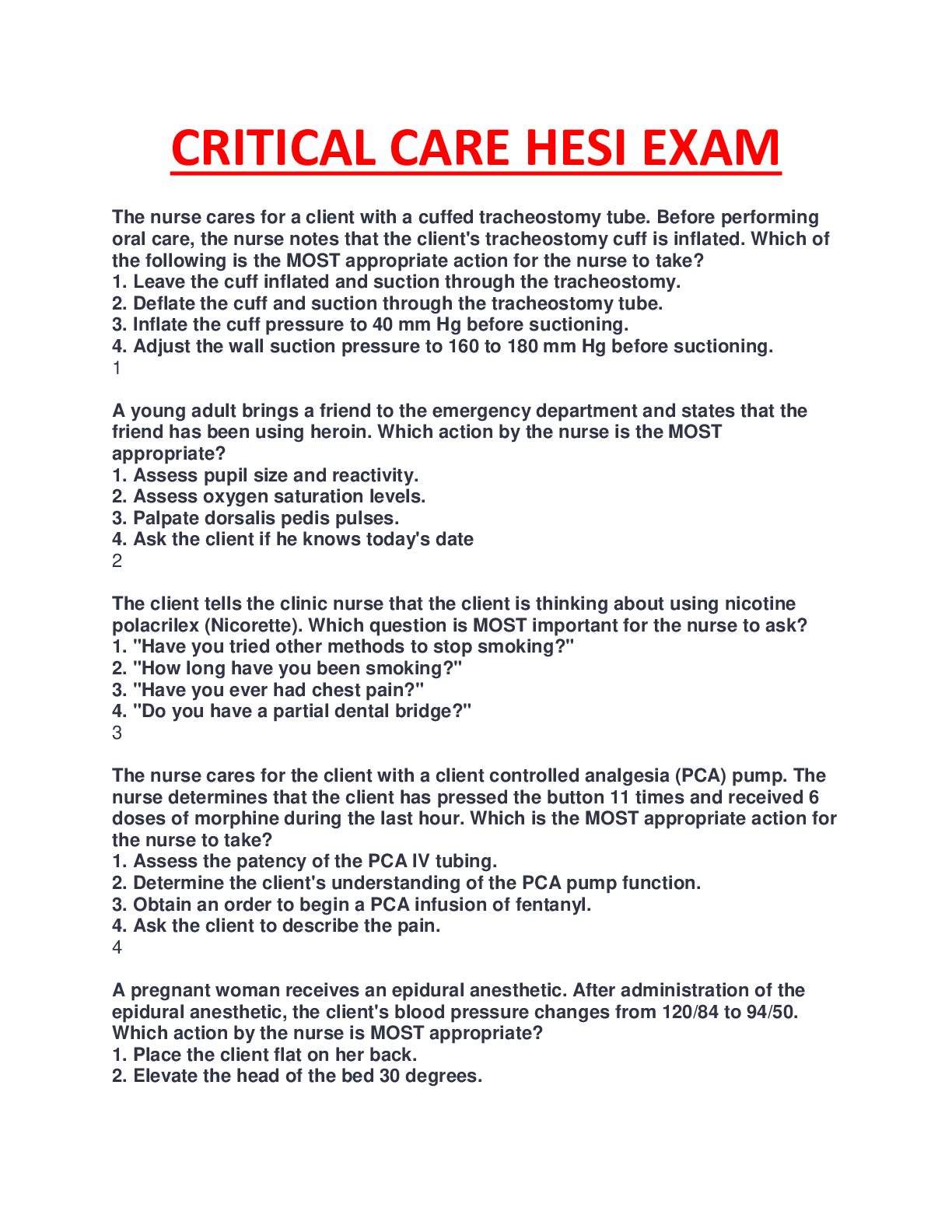
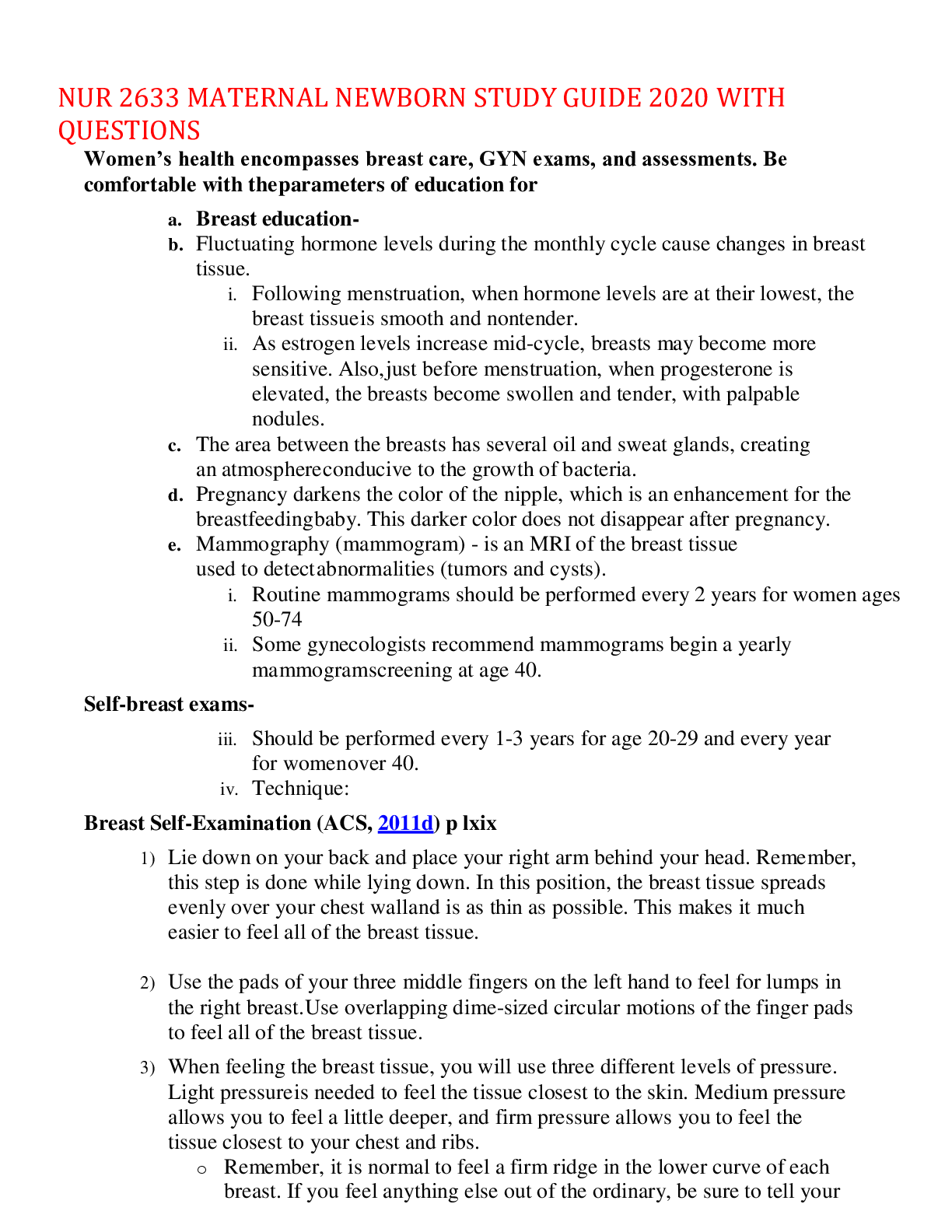

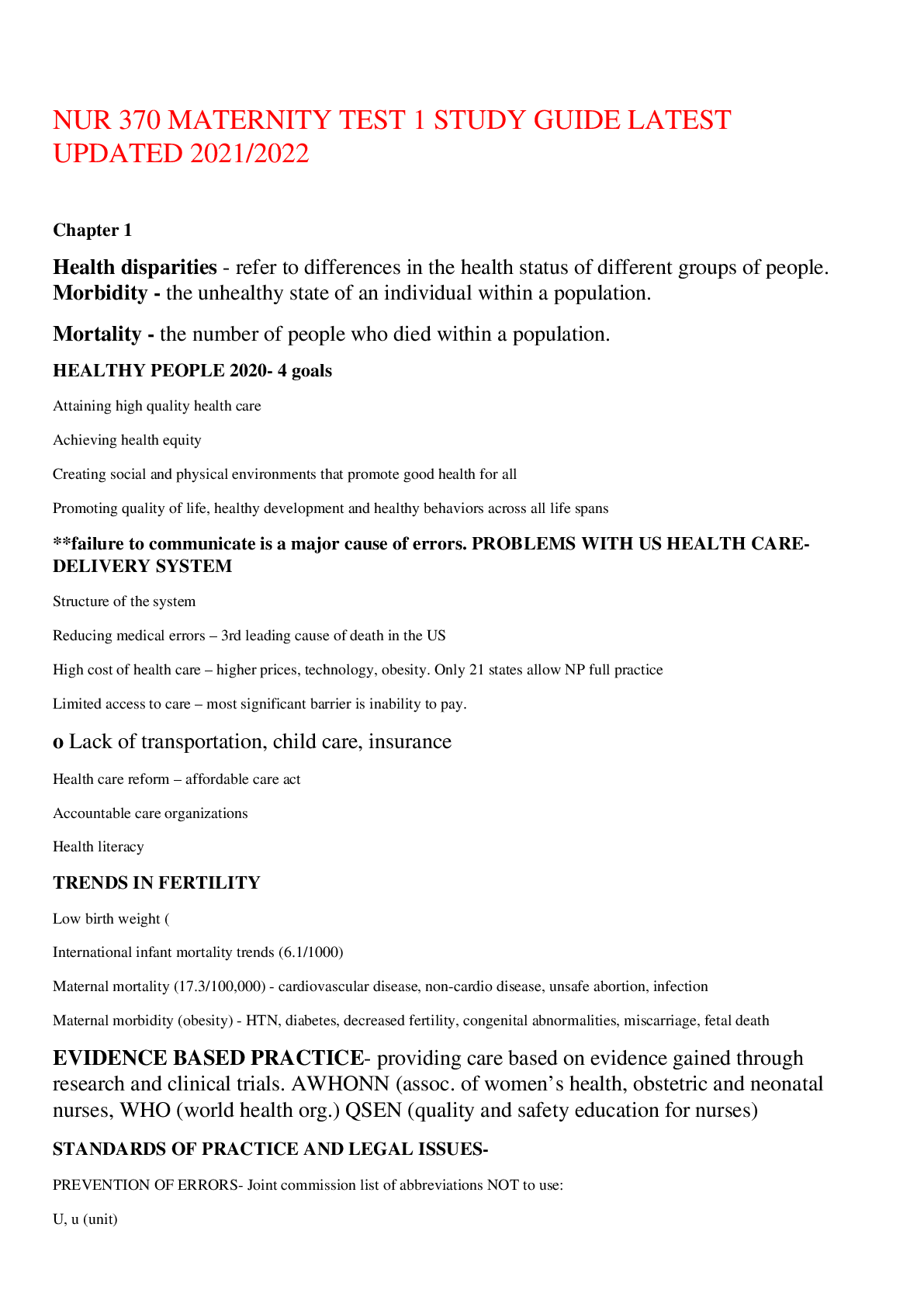
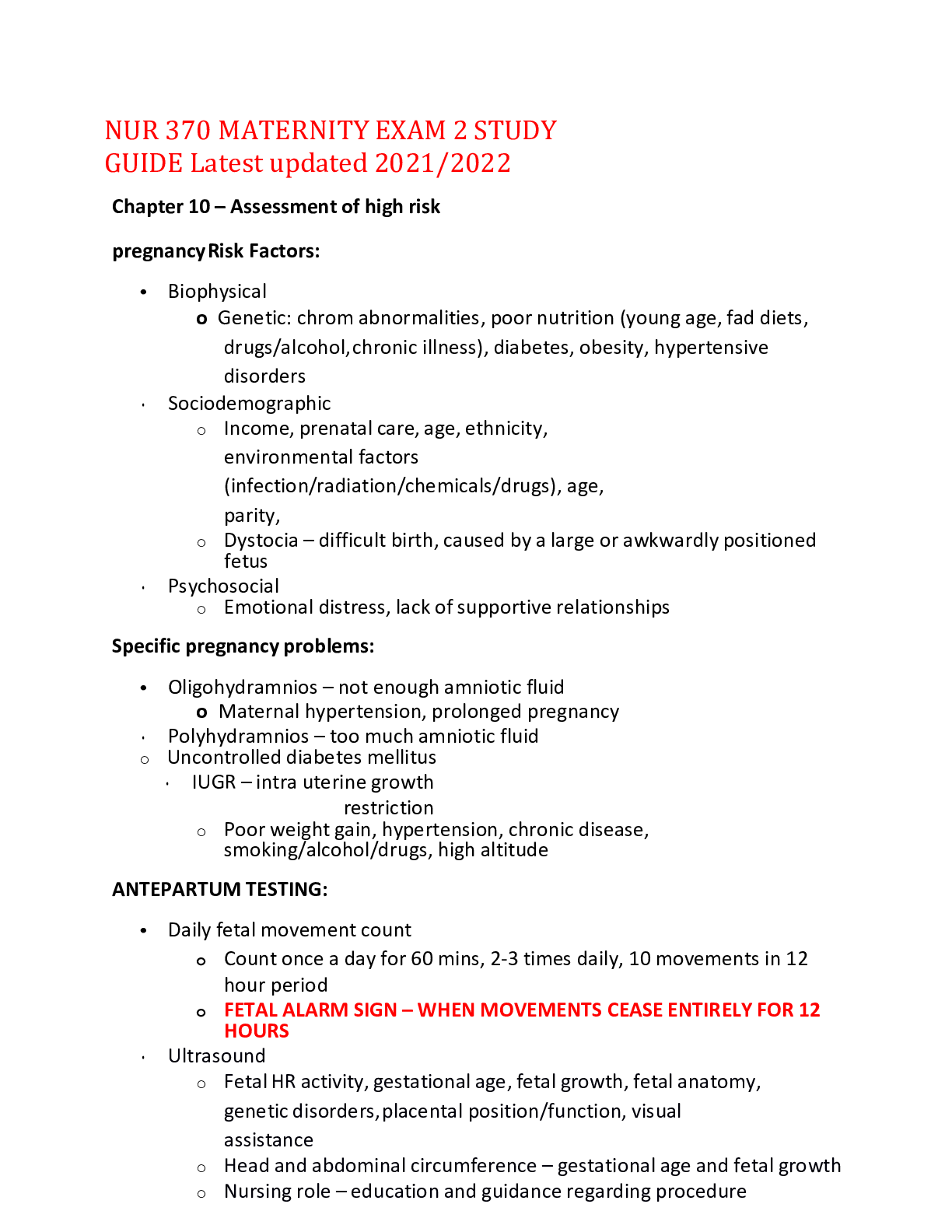
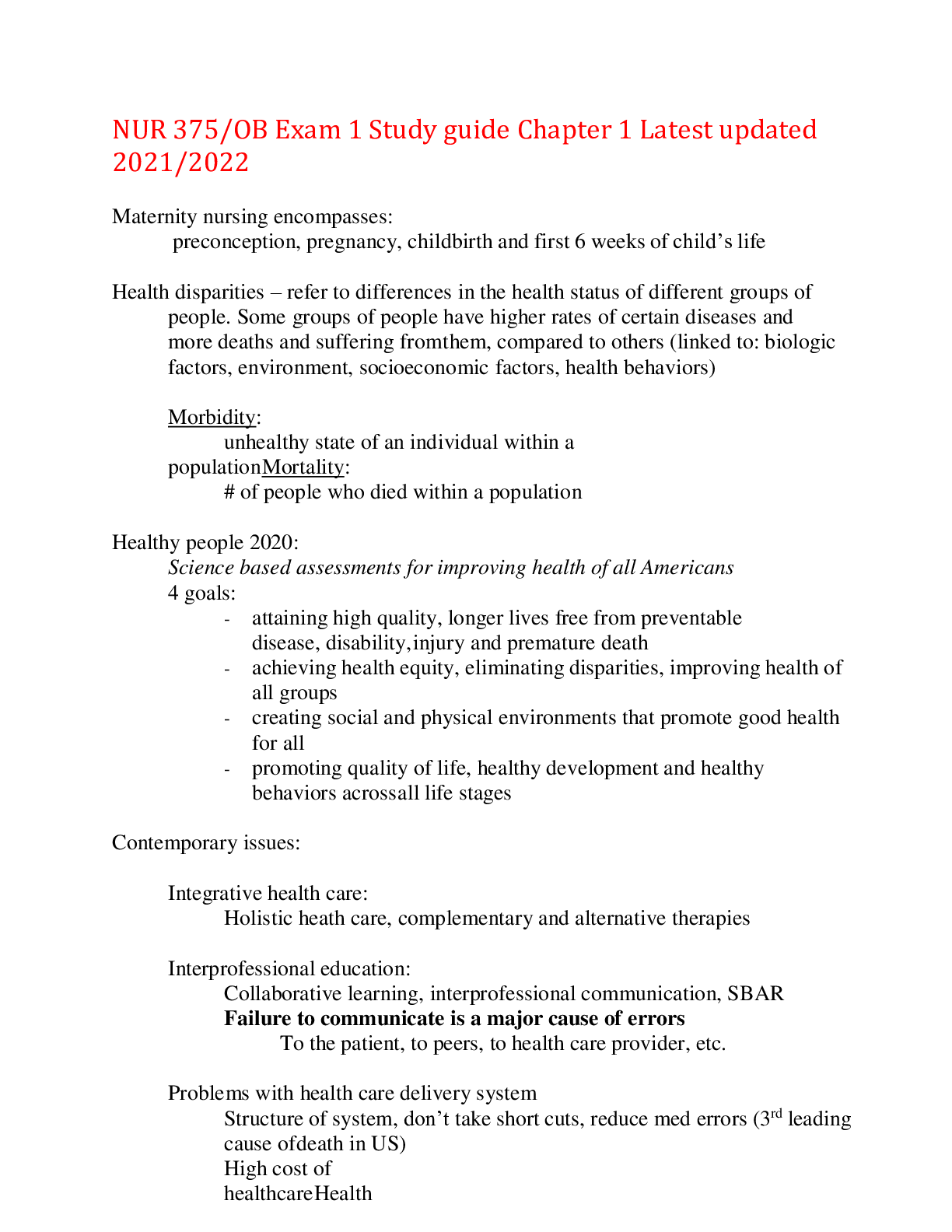
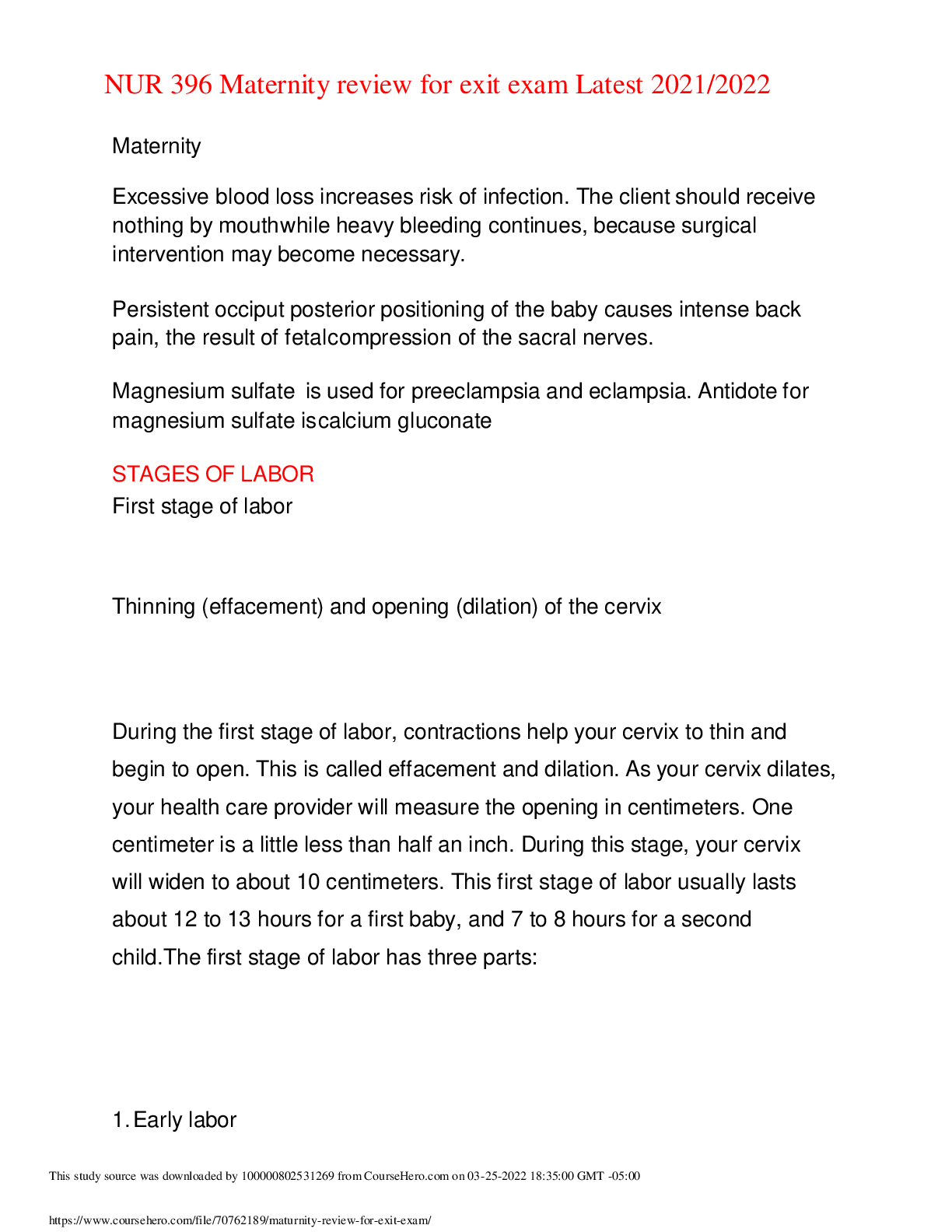
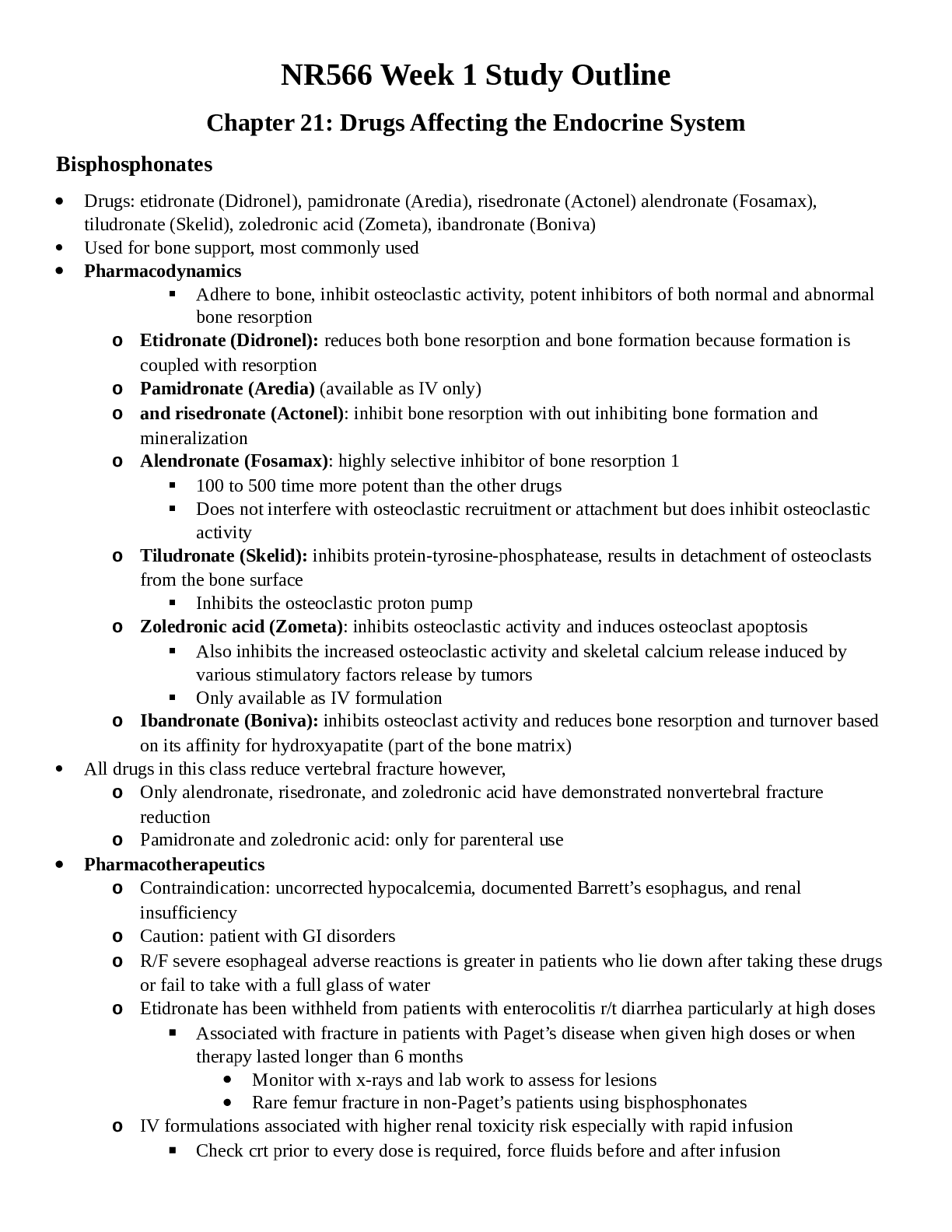
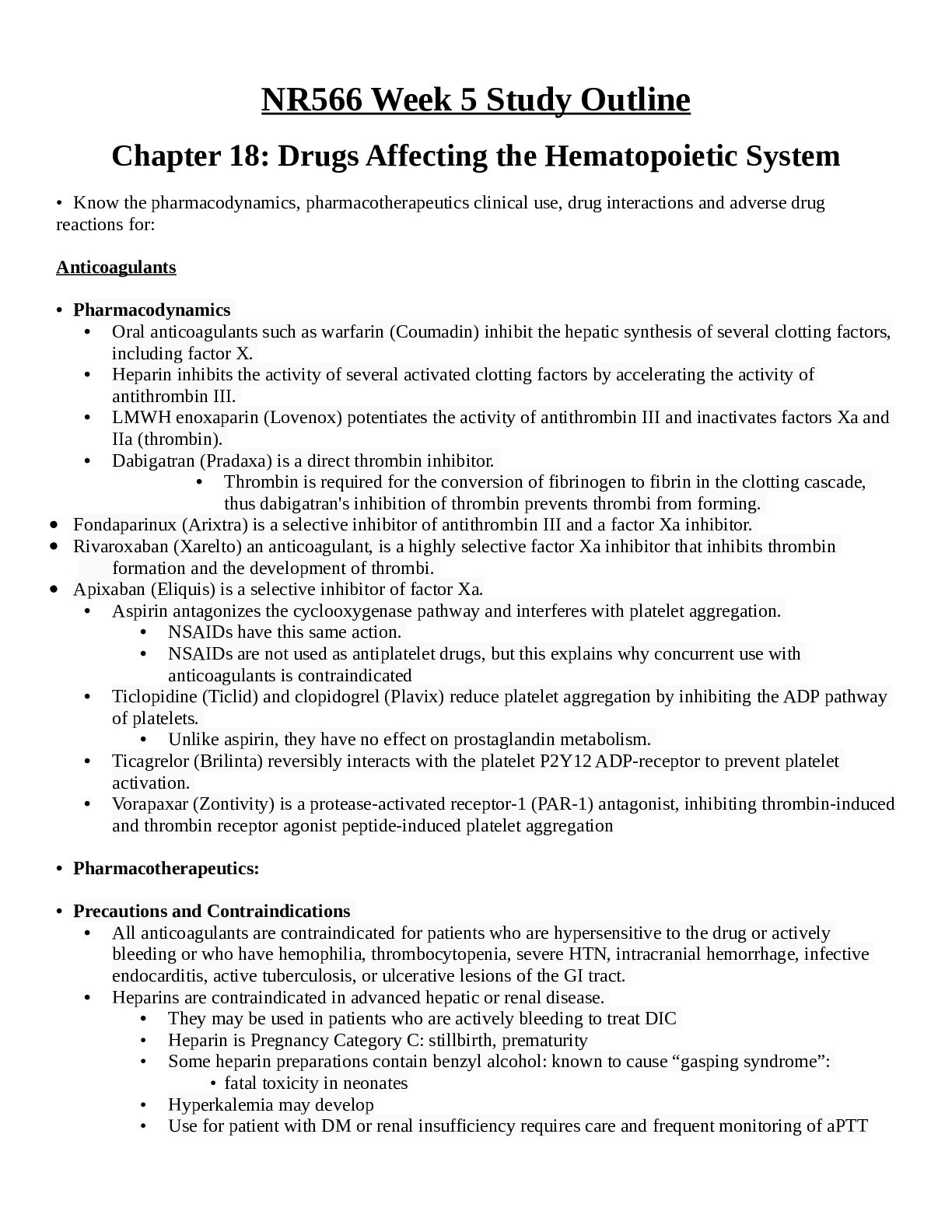
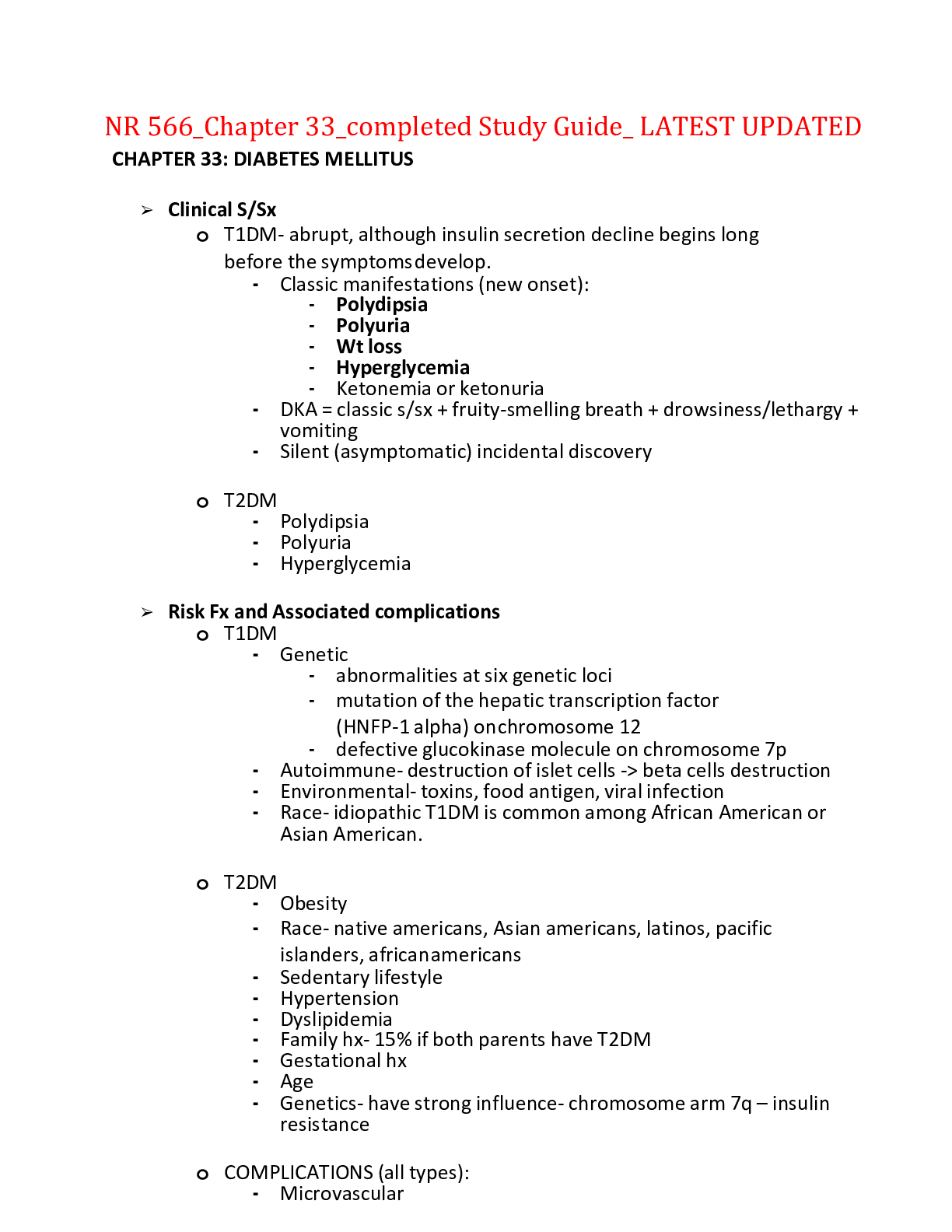
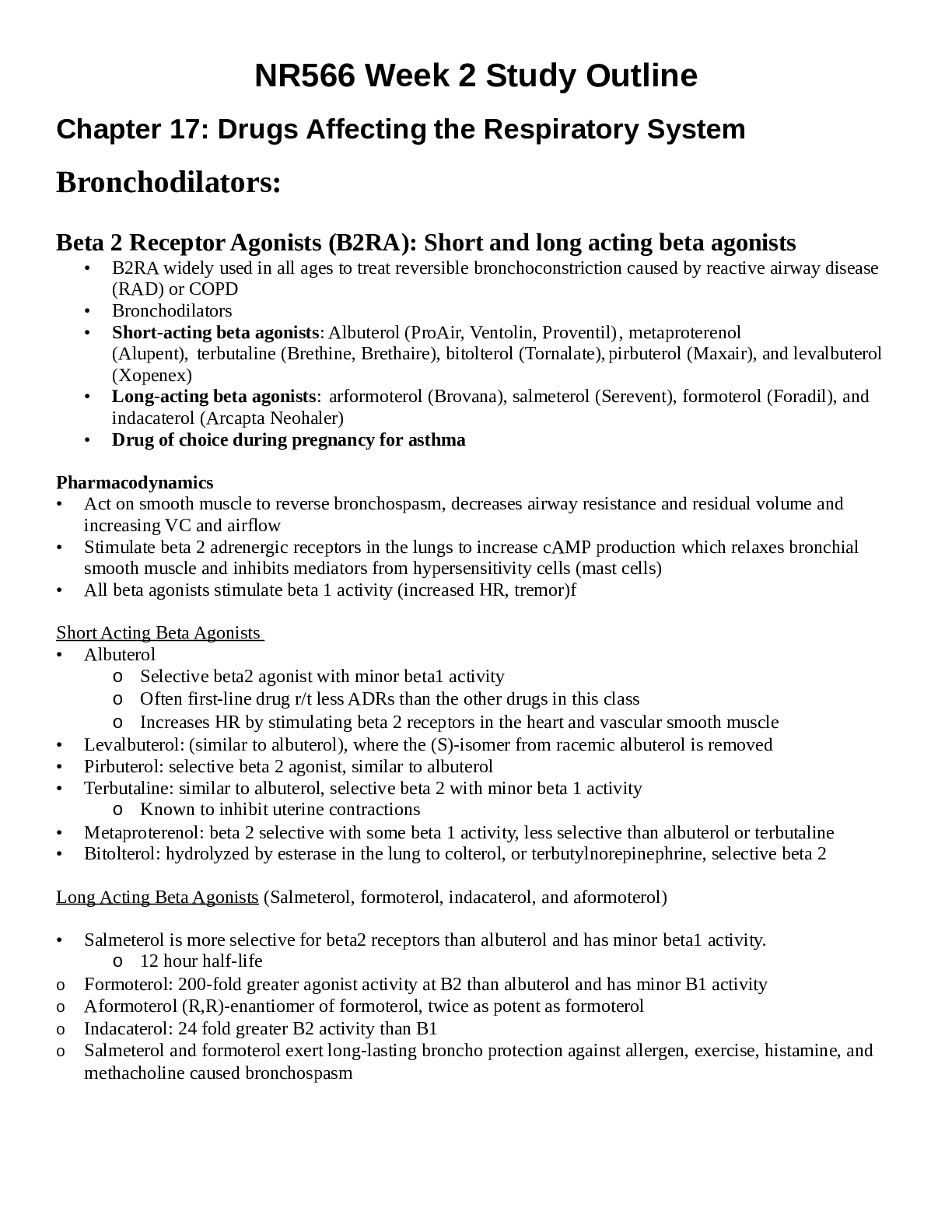
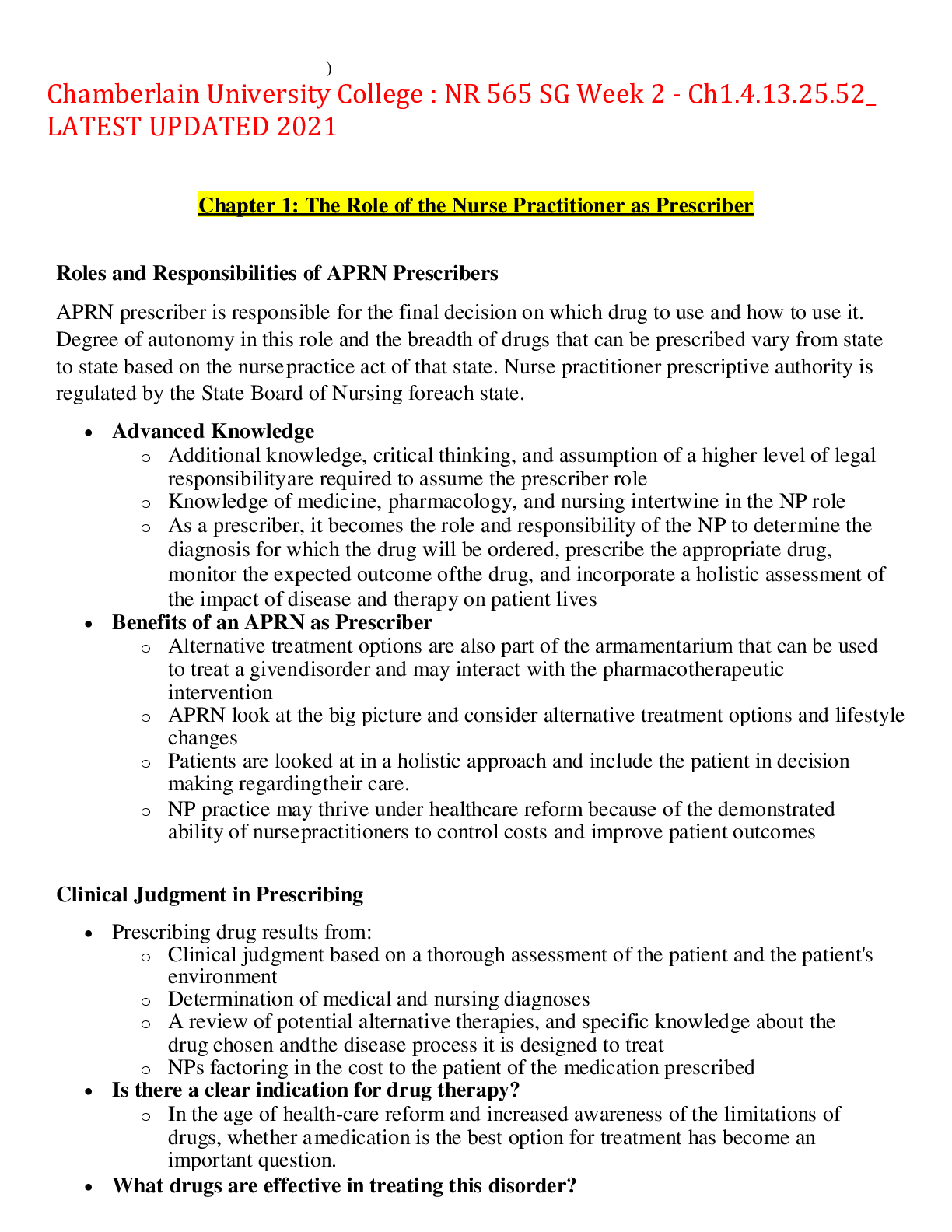


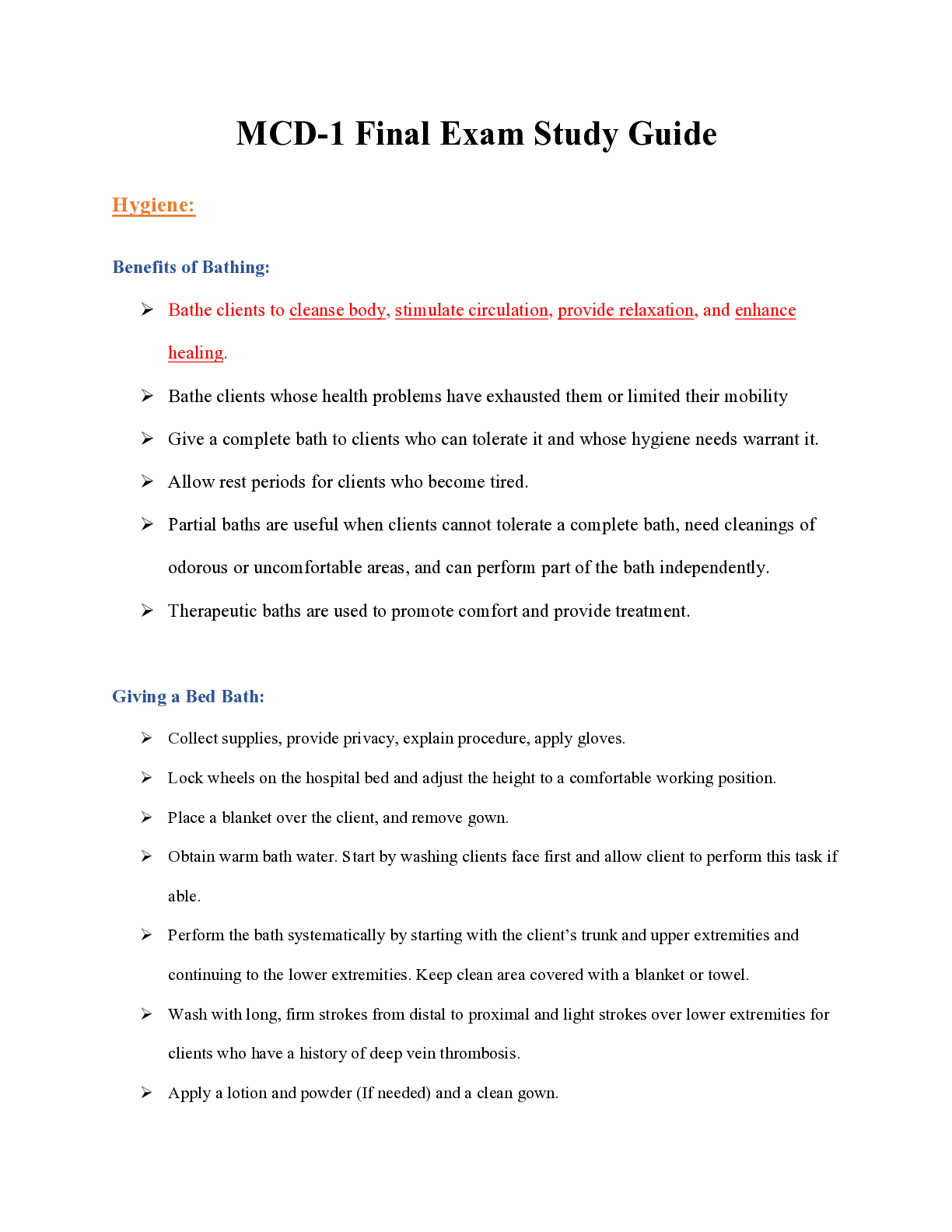






.png)

